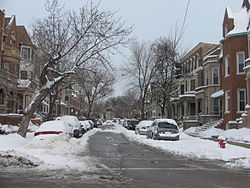Washington Park Court District
Department of Streets & Sanitation | |
|---|---|
| Location | Chicago |
| North end | East 49th Street (one-way east) |
| Major junctions | East 50th Street (hosts additional contributing properties.[1]) |
| South end | East 50th Street (one-way west) |

The Washington Park Court District is a
The district includes
Architecture
Washington Park Court, which runs one-way northbound from East 50th Street to East 49th Street, is a one-city block-long street located at 432 east in the Chicago street numbering system. Officially, it runs from 4900 south to 5060 south in the numbering system.[3] The street and several adjacent homes at one end are recognized as a distinct district within the city, according to the City of Chicago Department of Planning and Development.[2] In May 1990, the district was one of ten that were under consideration for Chicago Landmark status,[7] and it was designated a Chicago Landmark on October 2, 1991.[2] The district was named for the Park,[3] which was designed by landscape architect Frederick Law Olmsted.[8]
The T. G. Dickinson Real Estate Company, which created the subdivision in 1892, mandated 10-foot (3.0 m)
Demographic change
Between 1900 and 1934 the African American population in Chicago grew from 30,000 to 236,000.
During the first half of the 20th century,
Eventually the term Black Belt included the region from 39th Street to 95th Street between the
Notes
- ^ "Washington Park Court District Map". City of Chicago Department of Planning and Development, Landmarks Division. 2003. Retrieved January 2, 2009.
- ^ a b c d e f "Washington Park Court District". City of Chicago Department of Planning and Development, Landmarks Division. 2003. Retrieved March 30, 2007.
- ^ ISBN 0-8294-0597-6
- ^ ISBN 0-15-602908-1. Retrieved January 4, 2008.
- ^ ISBN 0-7391-1029-2. Retrieved January 3, 2009.
Washington Park Court.
- ^ Chicago Historical Society. Retrieved February 14, 2009.
- ^ Newsbank. Retrieved January 2, 2009.
- Chicago Historical Society. Retrieved February 14, 2009.
- ^ a b c d e Kamp, Allen R. (1986–1987). "The History Behind Hansberry v. Lee" (PDF). UC Davis Law Review. 20. University of California, Davis: 481–500. Archived from the original (PDF) on June 12, 2010. Retrieved January 2, 2009.
- ^ Chicago Historical Society. Retrieved December 31, 2008.
- ^ Chicago Historical Society. Retrieved February 14, 2009.
- Chicago Historical Society. Retrieved December 31, 2008.
- ISBN 978-1-56000-857-6. Retrieved January 4, 2008.


